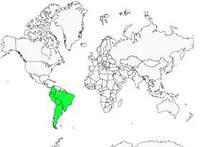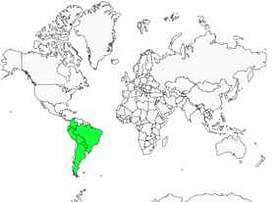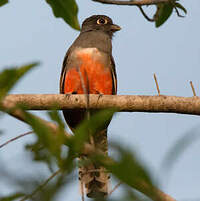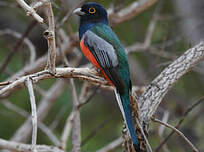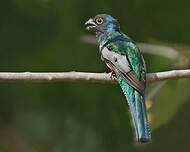Blue-crowned Trogon
Trogon curucui - Trogon couroucou
Identification
Blue-crowned Trogon, also known as Trogon curucui, has a distinct dimorphism. The male is the only trogon with an orange orbital ring and a slightly curved yellow bill with black whiskers on either side. Its crown and nape are navy blue with shiny highlights while its parotids are black, mantle and back are emerald green, while its rump and upper tail-coverts turn to turquoise blue. The upper rectrices are of the same blue and the tip of the tail has a horizontal black bar. Its chest is deep navy blue with a hint of violet reflection, and has a white band that can be absent in some individuals or subspecies, separating the chest from the red-vermilion belly. Like in many trogons, the coverts have fine white and grey waves, its primary remiges are anthracite with clear white edges. The lower rectrices have two white marks near the tip, the third mark is in the middle and the tail is horizontally striped with black and white. The female replaces the blue crown and chest to a pale grey, and its bill is pale yellow; its eyes have two half-orbital white circles around it; its parotids are darker grey instead of black like the male's. Its mantle and back are grey, as well as its scapulars; and the coverts are markedly rippled with black and white horizontal waves, which are even wider in the second and third remiges.The primary remiges are almost black with always clear white edgings. The gray chest is separated from the red abdomen by a wider white line than that of the male. The marking of the lower rectrices is totally different, three vertical black marks of decreasing length up to the end of the tail are clearly visible, the outer edges are white with light black marks, the end of the tail bearing a horizontal black mark. The gray tarses are hardly visible. The juveniles have the plumage of their mother, the immature males start to adopt the color of their father but with duller shades, the lower rectrices are not yet marked in black and white but are rather greenish. Three subspecies (ssp) are recognized, ssp curucui which gives its name to the species east of the Andes (Colombia, northeast Brazil, Bolivia, Paraguay and northwest Argentina); ssp peruvianus (Colombia, north of Brazil, Peru), does not have a white band on the chest, mantle and back are predominantly blue, lower rectrices more striped, the three white marks are smaller than those of the nominal species, the female has only a diffuse white spot at the limit of the chest and belly, the lower and upper rectrices are anthracite bordered by small black and white horizontal lines; ssp behni generally larger (east of Bolivia and northwest Argentina, east Brazil and Paraguay), has the same type of marking as curucui but the classic green of curucui transforms into copper green. The three subspecies definitely hybridize which will not make identification any easier! Possible confusion with Blue-crowned Trogon (Trogon couroucou), or even Trogon personatus.
Subspecific information 3 subspecies
- Trogon curucui curucui (e Brazil)
- Trogon curucui peruvianus (s Colombia to Bolivia and c Brazil)
- Trogon curucui behni (e Bolivia, sw Brazil, Paraguay and n Argentina)
Foreign names
- Trogon couroucou,
- Trogón curucuí,
- surucuá-de-barriga-vermelha,
- Blauscheiteltrogon,
- Amazon-trogon,
- Blauwkruintrogon,
- Trogone capoblu,
- blåkronad trogon,
- Blåkronetrogon,
- trogón modrohlavý,
- trogon modrotemenný,
- Blåisset Trogon,
- alankotrogoni,
- trogon de capell blau,
- trogon niebieskogłowy,
- Синешапочный трогон,
- ズアオキヌバネドリ,
- 蓝顶美洲咬鹃,
- blåkronad trogon,
- 藍頂美洲咬鵑,
Voice song and call
Habitat
The Blue-crowned Trogon has a wide distribution in South America, showing a great ability to adapt. It can be found in primary and secondary forests, high up in the canopy, along the banks of all the rivers and streams of the Amazon and Pantanal, the varzea, but it also prefers the more sparsely populated forests of Mato Grosso. It has been observed in Bolivia at 1,750 m and is common in Argentina at 1,500 m.
Behaviour character trait
Often seen in pairs, rarely in colonies or small groups, the Blue-crowned Trogon is a sedentary bird. Although benefiting from a wide variety of habitats, American ornithologist David Pearson noted in 1971 in Peru that they could primarily be found in the lower or medium canopy (7 to 25 m) not very often perched higher, at heights of 25 to 40 m. Usually perched to scan for its environment and hunt for insects, it would then swoop down on its prey.
Dietfeeding habits
Reproduction nesting
Depending on the location, different times of the year are best for spotting the Blue-crowned Trogon: May in Colombia, July in Peru and in the Brazilian Amazon, and September in Mato Grosso. They nest often in arboreal termite nests (Nasutitermes corniger), in which they create a 6-7 cm diameter opening and then build a tunnel of 15 cm that leads to a chamber. Generally, three eggs are incubated, but there is almost no information on the incubation period or the raising of chicks.
Geographic range
Threats - protection
IUCN conservation status
concern
in the Wild
threatened
evaluated
The LC does not present any particular concern other than the usual excesses of our civilization: deforestation, population expansion, pesticides, pollution. As with all Trogons, we must preserve our environment in order to preserve the species, such as the Blue-crowned Trogon.
Sources of information
- IOC World Bird List (v15.1), Gill, F and D Donsker (Eds). 2025-12-07.
- A Field Guide to the Birds of Brazil, Ber Van Perlo
- A Natural history of the Trogonidae, Joseph M.Forshaw Albert Earl Gilbert
- Birds of Peru, Thomas S.Schulenberg, Douglas F.Stotz, Daniel F.Lane, John P.O'Neill, Theodore A.Parker III
- Vol. 6 - Handbook of the Birds of the World, Josep del Hoyo-Andrew Elliott-Jordi Sargatal
- xeno-canto, Sharing bird sounds from around the world,
- Arthur Grosset's Birds, Arthur Grosset
- Avibase, Lepage Denis
- Wikipédia, Wikipedia, The Free Encyclopedia
Other sources of interest
 Specification sheet created on
31/07/2023 by Anne et Gabriel Leboff
Specification sheet created on
31/07/2023 by Anne et Gabriel LeboffTranslation by AI Oiseaux.net
© 1996-2026 Oiseaux.net
- Accipitriformes
- Aegotheliformes
- Anseriformes
- Apodiformes
- Apterygiformes
- Bucerotiformes
- Caprimulgiformes
- Cariamiformes
- Casuariiformes
- Charadriiformes
- Ciconiiformes
- Coliiformes
- Columbiformes
- Coraciiformes
- Cuculiformes
- Eurypygiformes
- Falconiformes
- Galliformes
- Gaviiformes
- Gruiformes
- Leptosomiformes
- Mesitornithiformes
- Musophagiformes
- Nyctibiiformes
- Opisthocomiformes
- Otidiformes
- Passeriformes
- Pelecaniformes
- Phaethontiformes
- Phoenicopteriformes
- Piciformes
- Podargiformes
- Podicipediformes
- Procellariiformes
- Psittaciformes
- Pterocliformes
- Rheiformes
- Sphenisciformes
- Steatornithiformes
- Strigiformes
- Struthioniformes
- Suliformes
- Tinamiformes
- Trogoniformes


